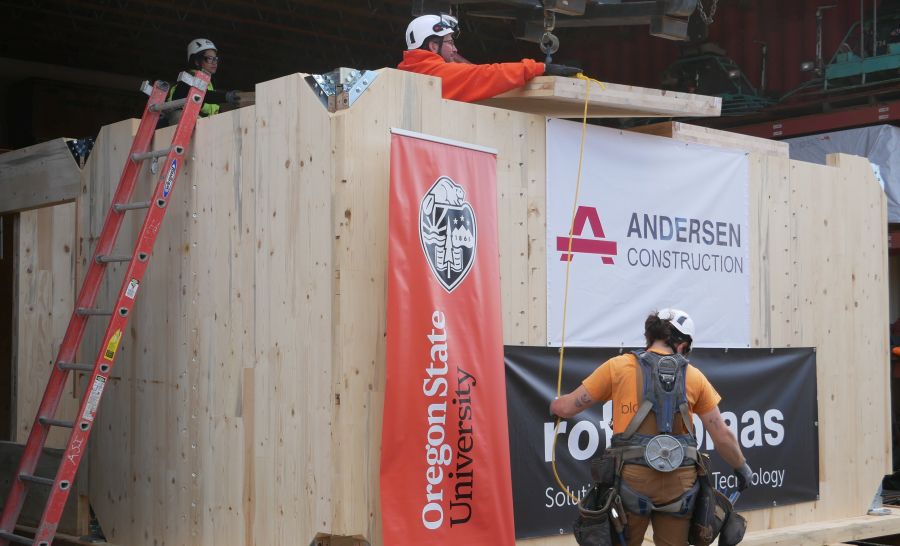COF professor is on a mission to build better for a more sustainable future.
The building sector is a major contributor to human environmental impacts on the planet – and the College of Forestry’s Mariapaola Riggio is researching ways to mitigate that impact through more sustainable building practices. She’s currently working on projects that take a more environmentally-friendly approach to building through the use of mass timber technologies and what’s known as a “circular economy” model.
Riggio, associate professor of wood design and architecture in the department of wood science and engineering, describes the concept of “circular economy” as a necessary shift in the construction industry, which will help extend the life of buildings and promote more sustainable building practices.
“The current linear consumption model of raw material extraction, production, use, and disposal, which dominates the global economy, is no longer sustainable,” she explains. “In contrast to this model, circular economy aims to slow the consumption loop by designing products that can last longer, be reused, remanufactured or recycled. It also looks at narrowing resource flows, using for instance waste or underutilized materials.”
She describes how these approaches are applied in some of her recent projects:
The first project focuses on how to use an underutilized forest resource to construct affordable, reusable shelters. The material that Riggio’s team worked with is ponderosa pine. Specifically, ponderosa pine taken from restoration programs that harvest trees in order to prevent or mitigate wildfires. These smaller ponderosa pines are removed from forests to preserve larger trees.

Ponderosa pines harvested from restoration programs are generally not considered very marketable for construction as they’re small, knotty, and the resulting boards are often warped or twisted. Riggio wanted to investigate whether they could actually be useful building material, if they were directed at the right type of structure.
She looked into building low-rise modular homes with cross-laminated timber panels made of ponderosa pine lumber. Through working on a prototype, she found that this could be an effective way to utilize this low-value lumber. The smaller dimensions of the structure are more suitable to ponderosa pine’s characteristics and the structure itself is sustainable, as it can be broken down and reconstructed as needed.
One potential use for such structures would be to house populations displaced by disasters or conflicts, as there’s often a need to provide quick and affordable shelter in the wake of disruptive and catastrophic events. Using ponderosa pine from restoration projects adds value to costly wildfire prevention and mitigation work.
“This is a promising way to use waste to engineer wood products – and build structures with a long service life,” she said. She explains that this project is an example of what is called a “narrow-close loop” in the building process, because it optimizes use of resources and reuses materials disrupting the need to demolish and dispose of buildings.
In another project, Riggio transformed the College of Forestry’s Peavy Forest Science Center (PFSC) into a living laboratory to examine the long-term performance of mass timber buildings. She installed structural health monitoring systems around the PFSC to track different factors that could affect the life of the building, like moisture levels that could lead to rot or decay.
“This project will help us understand how a building performs over time,” she said. “And, it will help us make informed decisions about how to extend the service life of the building, through preventative or remedial actions, thus “slowing the loop” of a building life”
The monitoring project proved its usefulness already during the building construction stage, and helped the building team to make informed decisions, such as ventilating roof panels to avoid mold growth and revising the installation procedure of the building shear walls to ensure proper behavior of the structure during an earthquake. Riggio plans to continue monitoring the PFSC for issues and she plans to publish takeaways from the project that can be applied to future mass timber building projects.
Riggio also teaches the concept of a circular economy and offers students hands-on experience in this model through a collaborative course with the University of Oregon’s department of architecture. This course challenges a multi-disciplinary group of students to design small-scale timber structures using materials like recycled mass timber panels. They work together to assume the roles of manufacturer, engineer, and architect to create buildings that maximize future re-use of materials. In one recent class, students designed a Nomadic Hospitality Suite, which is a portable space that can be easily disassembled and reused.
Riggio will continue to build upon her research and academic work focusing on the circular economy and how to manufacture smarter buildings. “We hope to keep learning more and contribute to the conversation about how to build better for a more sustainable future,” she said.

